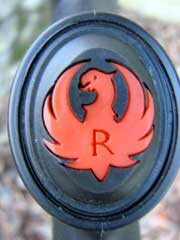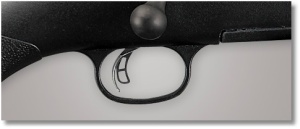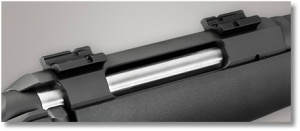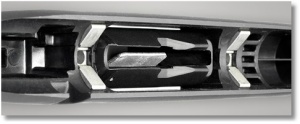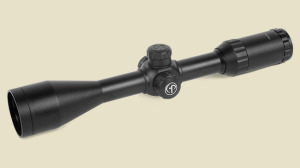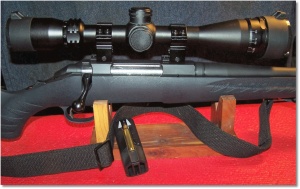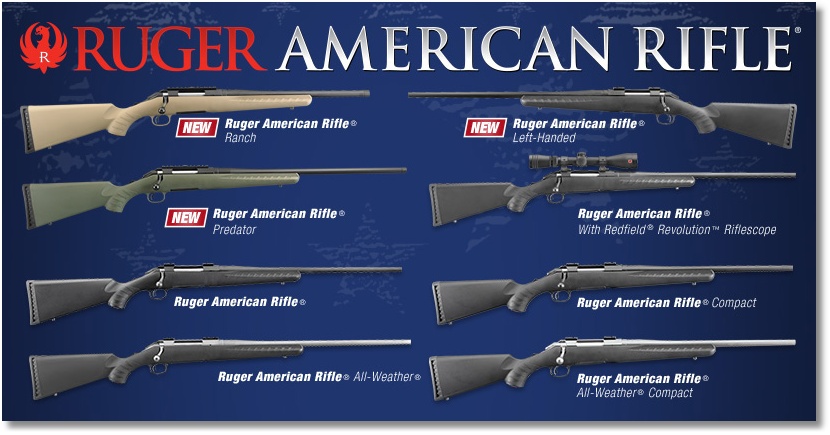To start out with, I was not even looking at these rifles as I have several hunting rifles of various calibers. A recent discussion with a good friend and certified armorer led me on a search for a bolt-action rifle chambered in .223 Remington. I had dropped my Ruger AR-556 for a trigger job and I began asking questions about several different rifles and his opinion of them. The discussion led into some problems that the local law enforcement agency was having with ammunition from a local manufacturer (no need to mention names). In fact, it seems that the several officers experienced serious malfunction with the ammunition and one officer was, in fact, injured when the receiver exploded. Apparently, the manufacturer was not crimping the cases enough. The result was the bullet actually separating from the case upon chambering and made it into the grooves. When the officer pulled the trigger, the gun went bang as it should have; however, the round did not exit the barrel. Being a semi-automatic, the AR chambered the next round and the officer pulled the trigger as he normally would. Unfortunately, the result of firing a fresh round into a stuck bullet did not fare well for the officer or the gun.
In another case (no pun intended), the bullet was set back into the case upon chambering.
The agency called the armorer in an attempt to find out why three very expensive tactical ARs blew up. The armorer quickly discovered the crimping problem; he pushed the bullet of a “new” cartridge against a hard surface and the bullet moved back into the case. The ammunition manufacturer admitted to nothing and the agency was down three weapons and still had a whole lot of the ammunition. The agency has a contract with the ammunition manufacturer so I am sure there will be repercussions.
As the story is unfolding, I’m thinking about all of the same .223 ammunition that I had purchased from this manufacture at gun shows. Not only do I have .223 but also .308. That made me skittish about firing any though the M1A and I decided that I now have a lot of it to push though my bolt guns and buy only quality factory ammunition for the M1A and my ARs.
It just so happened that there was a local gun show today so I thought that I would amble over just to see what was available in .223 bolt-action rifles. One dealer had several Ruger American rifles in various calibers and configuration. Among them was the Model 6913 .223. Actually, there were two; one with a scope and one without. The scoped model was a “youth’ model and since I am not a “youth” anymore I became interested in the un-scoped “standard” model.
 As I said, I was not interested in the Ruger American, but I was not ignorant of them either. I had read plenty of reviews on them and they were all favorable with one exception – the Ruger magazines. The Ruger magazines seem to be the weak link in an otherwise fine rifle. They are also expensive. Nonetheless, I was interested in the rifle. This particular vendor also had the Mossberg MVP chambered in the same .223 caliber.
As I said, I was not interested in the Ruger American, but I was not ignorant of them either. I had read plenty of reviews on them and they were all favorable with one exception – the Ruger magazines. The Ruger magazines seem to be the weak link in an otherwise fine rifle. They are also expensive. Nonetheless, I was interested in the rifle. This particular vendor also had the Mossberg MVP chambered in the same .223 caliber.
The Mossberg MVP has also had good reviews and so it was under consideration. The stock is very nice and everything looked nice about the rifle. I could not test the trigger due to the action locking requirement of the show. The magazine; however, was not too my liking. I have cooking pots with better metal than the magazine for the Mossberg MVP. The magazine was also so loose in the magwell that I automatically discounted the rifle as something that I wanted to have. It was time to take a walk and have a talk with myself.
No other vendor had the Ruger American so I sauntered back to the table. Luckily, the vendor would deal and we came to a cash-and-carry price agreement. After filling out the necessary 4473 and laying down the necessary cash, the Ruger American Model 6913 in .223 Remington walked out with me.
I’m not going to go into a lot of detail here about the rifle. Jeff Quinn at Gunblast.com has down a very good job with the Ruger American in .30-06 and all of the Ruger American rifles share the same features and quality (http://www.gunblast.com/Ruger-American.htm). However, I am going to share some (IMHO) important points about the rifle.
The Ruger American is outfitted with one of the best triggers that I have felt out of a production rifle. The Ruger Marksman trigger is very crisp at 3.5 pounds out of the box. It is also user adjustable to a degree. You will not get any less than 3 pounds or any more than 5 pounds. The trigger has a center safety lever (think Glock or any pistol with the trigger lever) and the gun will not fire without this lever being pressed. Essentially, the trigger is a two-stage trigger; a little take up and then bye-bye bullet. The safety is mounted where one is supposed to be – on the tang. No iron sights on the Ruger American; this rifle is made to be scoped and Ruger provides the Weaver mounts to do so. The hammer-forged, target-crowned barrel is 22 inches and has a 1:8 twist, which means it can handle any weight of .223 bullet available to me. The barrel is also free-floating; the stock has molded-in Ruger Power-Bedding recoil/bedding blocks. I have no idea of the finish, but it is evenly applied and the finish says “utility” as it is flat and blends well with the sculptured synthetic stock.The Ruger American utilizes a 70-degree full-size bolt body with three locking lugs and one heck of an extraction system; even slow extraction will send the case well clear of the rifle. The rear of the bolt can also serve as a “cocked” indicator; when the indicator protrudes from the bolt, the rifle is cocked. The bolt is removed easily by pressing a lock lever on the left side of the rifle.
Although there are several versions of the Ruger American, this particular rifle is the full-size version and has a 13.75-inch LOP, which is darn near perfect for me. The soft recoil pad will readily accept the mild recoil of the .223 and stem and stern sling mounts provide points for the Blackhawk QD sling mounts and SKS sling that is now mounted to the rifle.
The magazine for the Ruger American 6913 .223 is a five-round rotary unit that provides a 5+1 capacity, if needed. Magazines for this rifle are difficult to find and I have four on back-order. They are also expensive, but given the availability of them, too many is better than none. I cycled 40 rounds of 55-grain .223 varmint-tipped cartridges through the rifle (on full safe, of course) and did not have one failure to feed from the only magazine that came with the rifle. So far – so good. Honestly, I think that the Ruger American would be better served by the hinged-floor plate magazine used in the Ruger Hawkeye rifle. The capacity of the Ruger American magazine is the same as the hinged-floor plate magazine of the Ruger Hawkeye, which I prefer over a drop-box magazine in a hunting rifle if a magazine is going to be incorporated into one. Of course, Ruger would not be making money by selling magazines for an exorbitant price, would they now? When I arrived home, the first thing was to get a scope mounted. A quick trip to Wal-Mart made short work of obtaining a decent scope with rings; a Center-Point 4-16x40mm Adventure Class. I had used this scope before on several of my hunting rifles of greater caliber and it is a great scope for the money. I did feel that I was over-scoping the Ruger American rifle a bit for the caliber, but since the .223 is capable of 600 meters maybe I will be as well. The Ruger American is, after all, a hunting rifle. Besides, I saved a bundle at Wal-mart and was well under the asking price at Amazon.com.Some features of the scope:
- Adjustable objective from 4 to 16x power, Dual illuminated Mil-Dot reticle (red/green)
- One Piece, 1-inch tube
- Rated for airgun and firearm use
- Multi-coated lenses
- Finger turret adjustments
- FOV: 22.5-feet @ 4x and 6.3-feet at 16x
- Parallax setting: Adjustable from 10 feet to infinity
- Eye relief: 3.1-inches
- Adjustment: ¼-inch MOA @ 100-yards.
- Weight: 23.6 ounces
- Length: 14.125 inches
- Mounting: Weaver 1-inch quad scope mounts
- Bonus: Flip-up lens caps and 1-inch picatinny rings
Using the Wheeler fat wrench and the Wheeler level-level-level made short work of the mounting the scope. At first the scope seemed too high but actually fits me near perfect, but could be a hair lower. I may opt for different rings, as I have come to like the Warne Scope Mounts and don’t need QD mounts on a hunting rifle.
Obviously, the next step is some range duty to see how everything works together. Range results will be forthcoming – at some point – when I get around to it.
While I was not looking for a bolt-action rifle chambered in .223 Remington, I believe the Ruger American Model 6913 in .223 Remington will serve me well. It was not part of my bucket list or was even considered as a prospective purchase. Circumstances surrounding some possible problems with ammunition from a certain local ammunition manufacturer forced me to think about having a good bolt-gun to augment my ARs to run “suspected” ammunition through – they would be fine for a bolt gun but might not do well with the energy of the ARs bolt slamming home. Better safe than real sorry.From all indications, the Ruger American in .223 Remington will be a fine rifle for the AR enthusiast when they want to take a finger break from pulling the trigger as fast as one can.
Range Update:
After finally getting the scope leveled as it needed to be using the Wheeler Professional Reticle Leveling System (see article @ https://guntoters.com/blog/2015/03/14/wheeler-professional-reticule-leveling-system/), and replacing the original scope rings with Warne Scope Mounts Medium Matte Permanent Attach Rings (1-Inch), it was time to take the rifle to the range for the first time and zero everything.I was shooting Federal American Eagle 55-grain .223 FMJ at a 100-yard sight-in target set at 100 yards (a rare occasion for me). I dedicated ten rounds for zero and 10 rounds for post-zero verification.
Since I had never fired a bolt-action rifle chambered in .223, I wasn’t really sure what to expect.
I bore sighted the rifle on a target some 25-yards away to get me (hopefully) on paper at 100 yards and then commenced going for zero at 100 yards with a scope magnification setting at 7x.
With this ammunition I was experiencing an awesome display of muzzle flash. I have pushed .223 ammunition out my Windham Weaponry ‘SRC’ and noticed some muzzle flash with this ammunition, but the flash suppressor does a good job in dispersing the flash. Since the Ruger American does not have a flash suppressor, all of the flash was exiting the barrel straight away. The flash was actually lighting up the scope in the early morning daylight.
Six rounds later I was getting satisfied with my zeroing attempt. When I pulled off the seventh round; however, there was cause for concern. The rifle had fired fine, but there was no hole in the target where I expected it to be. I dropped the magazine and pulled the bolt from the firearm. There was daylight showing at the end of the barrel and my fears were alleviated – somewhat. I had to find that hole!
Pushing the scope to its full 16x power setting revealed that the round had impacted just off center of the previous round and left an elongated hole. All holes (rounds) were accounted for, I returned the scope to the 7x setting, and I fired the remaining three rounds to finalize the zero.
Since I had ten more ‘allocated’ rounds to play with, I choose to fire 5 at each bottom corner diamond.
I could not retrieve my target, because the designated cease-fire time had not been called, and I was running short on time. Looking through the scope; however, revealed a approximate 1.5″ group for one series of five shots. Not bad for a new rifle with a still to be broken in 3.5-pound trigger and a makeshift rifle rest (I had forgotten my bi-pod).
The Ruger American in .223 caliber is quite capable of getting me 1″ groups at 100- yards with better ammunition and if I settle in and do my part. I’m still researching ammunition for the rifle and will be trying some Remington 223, 55-grain PSP and the Winchester PDX1 Defender in the future.
The Ruger American in .223 caliber is intended to be a long-range shooter and a bolt-gun backup to my AR. The magazine hold 6 rounds and feeding from four magazines stoked with 5-rounds each fed flawlessly. Removing the magazines from the rifle is not an adventure and all magazines left the magazine well at a pull of a finger on the release latch. Extraction and ejection was positive. In fact, using my open-hand bolt operation technique kept several expended shells from bothering my neighbor that was shooting to the right of me.
The bolt is very smooth and lockup is tight. The 70-degree bolt allows adequate clearance with the ocular lens housing during operation. The bolt releases by pushing a lever on the left side of the receiver.
The safety is positive and I like it right where it is – on top of the rifle where it is supposed to be.
If you are considering a bolt-gun in calibers from 22-250 Remington to 30-06 Springfield, I can recommend the Ruger American as a viable choice.
Recoil with the Ruger American is light, but there is enough for you to pay attention to the fact that you are firing a rifle and not an airgun; there is no bolt release or buffering to soak up some of the recoil. The Ruger American does have a soft recoil pad and it works well. The bolt-action rifle in .223 would be a great rifle for training young ones or people new to shooting a long gun (IMHO) that has some punch to it. Recoil is less than with a .243 hunting rifle, but obviously greater than the .22 magnum.
Resources:
Ruger American Rifles: http://ruger.com/products/americanRifle/index.htmlSpecs for the Ruger American Model 6913 .223 Remington Rifle:
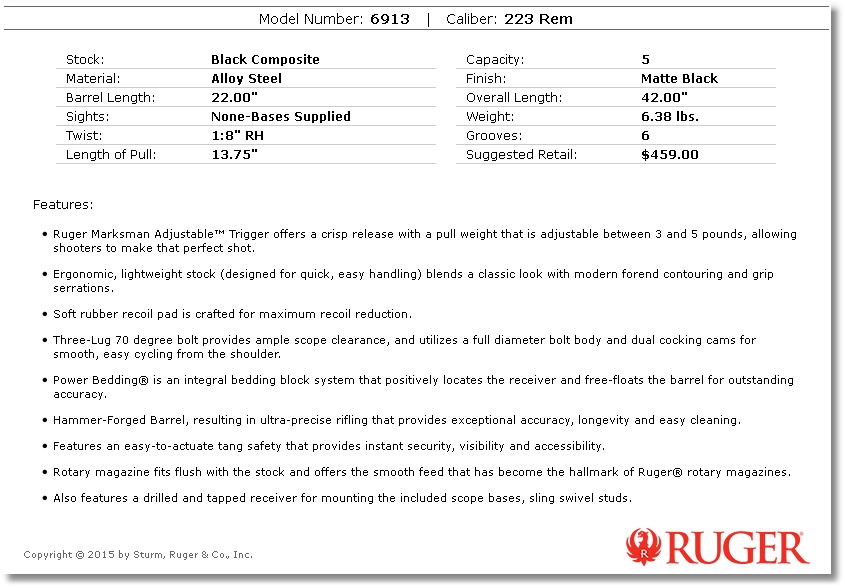
Crosman CPA416AORG2 Centerpoint 4-16x40mm Riflescope (http://www.amazon.com/Crosman-CPA416AORG2-Centerpoint-4-16x40mm-Riflescope/dp/B005WIAUUU/ref=sr_1_1?ie=UTF8&qid=1422137878&sr=8-1&keywords=center+point+4-16+scope)
Warne Scope Mounts Medium Matte Permanent Attach Rings (1-Inch) (http://www.amazon.com/dp/B000NK4JC2/ref=wl_it_dp_o_pC_nS_ttl?_encoding=UTF8&colid=Q8X6JBTGBISS&coliid=I8041CG7H7L4Z)
![]()


